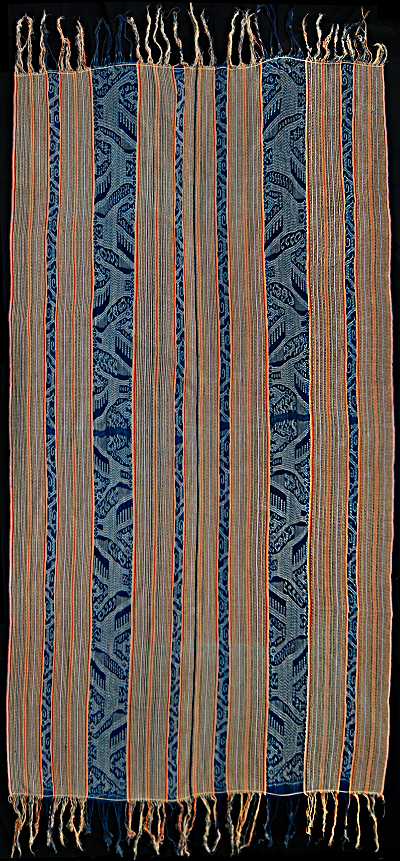| |
287 Timor, West Timor
Beti naek (men's wrap)  
|
| Locale: | Insana region, perhaps Ainuit village. |
| Period: | 1920-1945 |
| Yarn: | Cotton, hand-spun, medium - plus pinstripes in commercial thread. |
| Technique: | Warp ikat |
| Panels: | 2 |
| Size: | 110 x 207 cm (3' 7" x 6' 9") LW: 1.88 |
| Weight: | 545 g (19.2 oz), 239 g/m2 (0.78 oz/ft2) |
| Design: | Blanket, beti naik, in two panels. The two widest ikated bands are decorated with twelve partridges, here called manu fui (Ind. ayam hutan), the symbol of virility. Four narrower ikated bands are decorated with chicks, often used as a secondary motif next to roosters. Interspersed with accent stripes in sienna, ochre and pale yellow commercial thread are more than seventy stripes finely stippled in ikat two yarns wide. |
| Comment: | Hand spun cotton, all natural dyes, and clear drawing. With its fine drawing the piece emanates refinement. The detailing is a hallmark of Insana. As is occasionally seen also on early Amanuban blankets, the whites have not simply been reserved in their entirety, but spickled with short bars giving them a pale blue tint. This aesthetic choice has meant a vast increase in the number of bindings required. The pastel tones of the pin stripes makes the dark indigo ikat stand out in a very lively fashion. Cloth has clearly been used for a long time, but is in immaculate condition. Loosely twisted fringes. From old Dutch collection. |
| Background: | Chapters on Timor and West Timor. |
| Exhibited: | Timor: Totems and Tokens, Museu do Oriente, Lisbon, 2019/20. |
| Published: | Timor: Totems and Tokens, 2019.
Ikat Textiles of Timor: Indonesian and Timor-Leste, 2025. |
| Compare: | 094 132 258 |
| Sources: | Similar to probably younger Insana beti from Ainiut in Yeager and Jacobson, Plate 154, though with a yellowish rather than indigo overall tonality of the non-figurative ikat bands. Same proportions of wider and narrower ikated bands. A substantial difference is that the roosters are here shown in alternating, interlocking positions - as they are in Yeager and Jacobson, Fig. 128 b and h, though here with a more elegant interlocking that makes the figures merge into each other. |
| |

©Peter ten Hoopen, 2024
All rights reserved.
|


